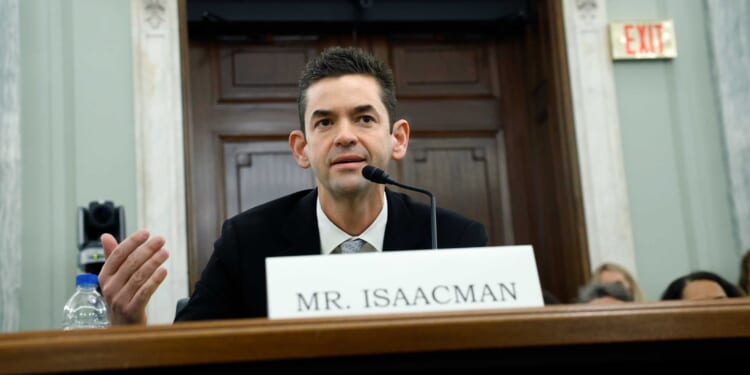One never has to wait long for a surprise from the Trump administration. In May, the White House withdrew Jared Isaacman’s nomination as NASA administrator. The billionaire entrepreneur and private astronaut had become a casualty of the spectacular spat between Trump and SpaceX founder Elon Musk, who was perceived to be Isaacman’s patron.
Then, last week, the White House announced that it was resubmitting Isaacman’s nomination. In a post on Truth Social, the president cited “Jared’s passion for Space, astronaut experience, and dedication to pushing the boundaries of exploration” as some of the qualifications that make him “ideally suited to lead NASA into a bold new Era.”
Finally, a reason to check your email.
Sign up for our free newsletter today.
Though not a complete shock (Isaacman supporters had been lobbying the president for weeks), the turnabout was nonetheless stunning. Most NASA backers and space industry leaders greeted the news with delight. “I’m thrilled for Jared and for NASA and the country,” Andy Lapsa, CEO of the private-launch company Stoke Space, told attendees at a recent conference. Space advocates hope Isaacman’s revived nomination will be the first step in fixing the deeply troubled agency.
In contrast to Trump’s first term in office—widely regarded as a high point in U.S. space policy—the president’s second term has so far been disastrous for NASA. Agency leaders stood on the sidelines as the White House proposed cutting NASA’s budget by nearly a quarter. Major decisions about staffing levels and which programs to cut fell into the hands of the Office of Management and Budget. Some 4,000 workers, about a fifth of the space agency’s staff, have left or been squeezed out. Meantime, plans to return U.S. astronauts to the moon are in disarray, even as China races ahead with plans to put its taikonauts on the lunar surface by 2030.
After yanking Isaacman’s nomination, the White House appointed Transportation Secretary Sean Duffy to become NASA’s acting administrator (in addition to his DOT duties). While Duffy appears to relish the many television appearances his NASA role entails, the space agency’s drift has only worsened under his stewardship.
Given Isaacman’s bipartisan support in the Senate—and lawmakers’ frustration with the status quo—he should easily win confirmation. His backers hope the Senate will move on the matter before the 2025 session adjourns. If not, the White House will have to resubmit the nomination, leading to further delays.
Space advocates have high, perhaps unrealistic, expectations that Isaacman will quickly bring order to NASA and straighten out the troubled Artemis lunar program. But, below the surface, the messy leadership drama exposed the lingering conflicts between factions inside NASA and in the larger aerospace community. The Isaacman saga also hinted at the swirling allegiances and rivalries within President Trump’s orbit. Once confirmed, the new NASA head will need to navigate this politically complex realm.
NASA watchers attribute Isaacman’s surprising comeback to several factors. First was the gracious way he handled the abrupt termination of his original nomination. “I am incredibly grateful to President Trump @POTUS, the Senate and all those who supported me throughout this journey,” he wrote on X within hours of his defenestration.
Isaacman then managed to stay out of the online food fight between the president and Elon Musk. He has self-funded two ambitious missions in SpaceX spacecraft. Musk recommended him to Trump partly based on that relationship. Nonetheless, Isaacman has been careful to keep some distance between himself and the mercurial SpaceX founder, to avoid coming across as anyone’s cat’s paw.
The once and future nominee also stayed close to Republican supporters, notably Montana senator Tim Sheehy and space enthusiast Newt Gingrich, with whom he penned an op-ed advocating for research into nuclear-powered space travel. Both men reportedly encouraged Trump to reconsider his snap decision to drop Isaacman’s nomination. The president has subsequently had dinner with Isaacman several times.
Finally, people just seem to like Jared Isaacman and find his enthusiasm contagious. “It helps that he is entirely genuine when it comes to wanting to serve the country and push NASA forward,” veteran space reporter Eric Berger told me by email.
Critics say Duffy’s self-aggrandizing approach to his acting role at NASA also tipped the scales toward Isaacman. By all accounts, the White House expected Duffy to identify a suitable candidate and quickly hand off the portfolio to an administrator with more aerospace experience. Instead, he began lobbying to keep his high-profile NASA duties. “There may have been a sense that Duffy was getting too big for his britches,” aerospace analyst Rand Simberg said in an email exchange. At one point, the acting administrator suggested folding NASA into the Department of Transportation, a move Simberg called “monumentally clueless.”
As Duffy fought to make his NASA role permanent, Berger said, he began “making decisions that he thought would improve his chances of remaining administrator, as opposed to best serving NASA.” For example, Duffy injected new uncertainty into the already fraught debates over the Artemis program, which aims to land Americans on the moon within this decade. In a planned Artemis III mission, NASA wants to use the famously overbudget Space Launch System (SLS) rocket to carry astronauts into lunar orbit. There, they would transfer to another craft for the trip to the lunar surface. SpaceX is under contract to modify its experimental Starship spacecraft to serve as this “Human Landing System” (HLS), though that project is running behind schedule. Jeff Bezos’s Blue Origin space company also has a contract to build its own HLS craft, which won’t be completed until the 2030s. Some experts suggest Blue Origin could use a smaller lunar cargo craft it is developing and modify it to carry astronauts. Blue Origin engineers are working on that project—which theoretically could be completed sooner—though it remains mostly notional for now.

(Photo by Austin DeSisto/NurPhoto via Getty Images)
In two television appearances last month, Duffy stirred up these muddy waters. First, he criticized SpaceX for its slow progress on the Starship HLS and expressed support for Blue Origin’s fast-track project. But he also said that NASA would open up the HLS competition to other companies. In particular, he proposed a “government option”—in other words, a lunar lander designed by NASA and built by aerospace contractors under the agency’s traditional cost-plus budgeting methods. Apparently, Duffy had been in discussion with Northrup Grumman, Lockheed Martin, and other contractors about the plan.
“This is, to put it politely, an insane idea,” Berger told me. Under the traditional cost-plus model, NASA designs its own space hardware and hires huge aerospace contractors to build it. Cost overruns get passed along to taxpayers. This is the approach that led to the underperforming space shuttle program and produced today’s wildly over-budget SLS.
For two decades, NASA reformers have tried to replace cost-plus contracts with leaner “commercial” deals under which contractors, such as SpaceX, build and fly their own hardware. NASA then hires SpaceX or another vendor to fly its cargo or astronauts for a fixed price. (I examined the advantages of fixed-price contracts in my Manhattan Institute report, “U.S Space Policy: The Next Frontier.”) While space advocates and reform-minded NASA leaders push for the fixed-price approach, legacy aerospace contractors and their friends in Congress often push back.
By dangling the cost-plus HLS idea before traditional contractors, Duffy was signaling that, if he were named NASA administrator, the old, more comfortable way of doing business would be back. In short, he was aligning himself with the “old space” power base of legacy contractors, NASA traditionalists, and lawmakers from aerospace-heavy states. Isaacman, by contrast, represents the “new space” contingent of aerospace startups, NASA reformers, and space buffs who yearn for a leaner but more ambitious space program.
Not long ago, the old-space bloc might have been powerful enough to put Duffy’s nomination over the top. But times have changed.
NASA watchers also noted the strange tale of Isaacman’s “Athena” plan. While awaiting confirmation, Isaacman and some advisors put together a private blueprint for reforming NASA. After his bid was scuttled, Isaacman passed a 62-page version of the plan along to acting administrator Duffy, in hopes that it might help him set priorities. In October, as the behind-the-scenes lobbying for the two NASA candidates intensified, copies of Isaacman’s plan began circulating among certain lawmakers and aerospace-industry leaders.
Isaacman’s allies suspected Duffy or someone in his circle had leaked the plan in hopes of rallying the old-space traditionalists to Duffy’s side. In truth, however, the Athena plan mostly reflected existing White House priorities, and even NASA’s biggest supporters recognize that the agency needs streamlining. In the end, as Space News noted, “If the leak was meant to block Isaacman’s return, it failed.”
What The Hill described as a “’Game of Thrones’ struggle for control of NASA” is also a window into the whipsaw politics of the Trump White House. When Musk held power as “First Buddy,” Isaacman’s eventual nomination seemed like a lock. Then, as Musk fell from favor, White House advisor Sergio Gor—who had clashed with the brash entrepreneur—seized the opportunity to sabotage the NASA nominee by slipping the president a file outlining Isaacman’s past political contributions to Democrats. This information had been available during the prospective nominee’s vetting process, but in the new, post-Musk atmosphere, Gor’s memo convinced Trump to scuttle Isaacman’s nomination.
Few certainties endure in the Trump White House, however. By November, Gor was out, appointed to become the U.S. ambassador to India. (“Some people don’t like him so much,” Trump quipped during Gor’s Oval Office sendoff. “I’ll be honest with you, Sergio.”) By then, Trump and Musk had patched up their bromance and Isaacman was back in favor as the president’s choice to run NASA. Among other things, the saga speaks to Trump’s extraordinary willingness to change course and bury old grudges.
Space advocates are gratified that the White House came around to the best choice for NASA administrator in the end. But frustration lingers over the long, chaotic process.
“NASA lost half a year,” Berger said. “Those months are critical in the context of shoring up Artemis III to land on the moon this decade.”
Isaacman now has a shorter window in which to sort out the lunar program, adapt NASA initiatives to a more austere era, and accomplish his many other goals. But the savvy manner in which he managed his wild ride suggests he has the skills and temperament for the job.
Top Photo: Jared Isaacman at his initial confirmation hearings last April (Kevin Dietsch/Getty Images)
Source link


















